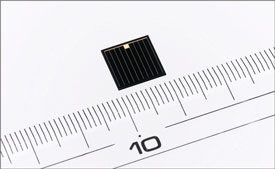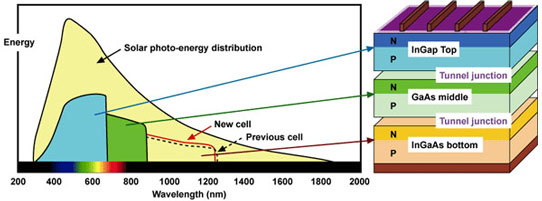Using a triple-junction III-V compound semiconductor solar cell (in which three photo-absorption layers are stacked together, Japan’s Sharp Corp has surpassed its record for energy conversion efficiency in research-level non-concentrator solar cells from 37.7% (set last September, though beaten by Spectrolab’s 37.8% earlier this month) to 37.9%.

Picture: Triple-junction cell with record efficiency of 37.9%.
Sharp says that it achieved this latest breakthrough as a result of an R&D initiative promoted by Japan’s New Energy and Industrial Technology Development Organization (NEDO) on the theme of ‘R&D on Innovative Solar Cells’ (in which Sharp has previously achieved triple-junction cell efficiency of 35.8% in 2009 and 36.9% in 2011, as well as 43.5% for a concentrator triple-junction cell, at 360-fold concentration, in June 2012). Measurement of the value of 37.9% was confirmed by Japan’s National Institute of Advanced Industrial Science and Technology (AIST).
The basic structure of the latest triple-junction solar cell uses proprietary Sharp technology that enables efficient stacking of the three photo-absorption layers, with an InGaP (indium gallium phosphide) top layer, GaAs (gallium arsenide) middle layer and InGaAs (indium gallium arsenide) bottom layer, separated by tunnel junctions. By optimizing the relative proportions of indium, gallium and arsenide, Sharp succeeded in increasing the efficiency with which the cell absorbs sunlight at its various wavelengths, enabling it to achieve the latest 37.9% efficiency record.

Graphic: Wavelength distribution of solar photo-energy and wavelength sensitivity of triple-junction cell for the InGaP, GaAs and InGaAs parts of the structure.
Sharp says that its aim for the future is to apply this latest development to concentrator photovoltaic (CPV) power systems that use lenses to collect and convert sunlight into electricity. The firm also foresees many other practical applications for the cells, such as on space satellites and vehicles.




